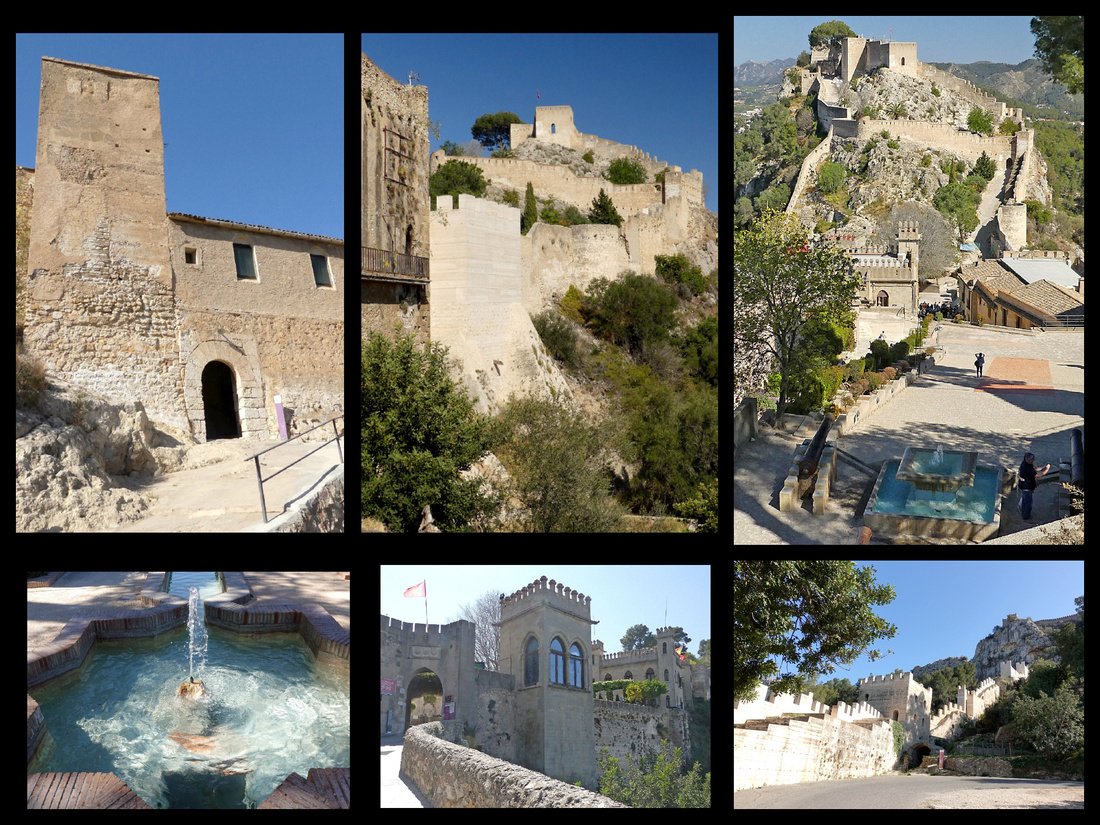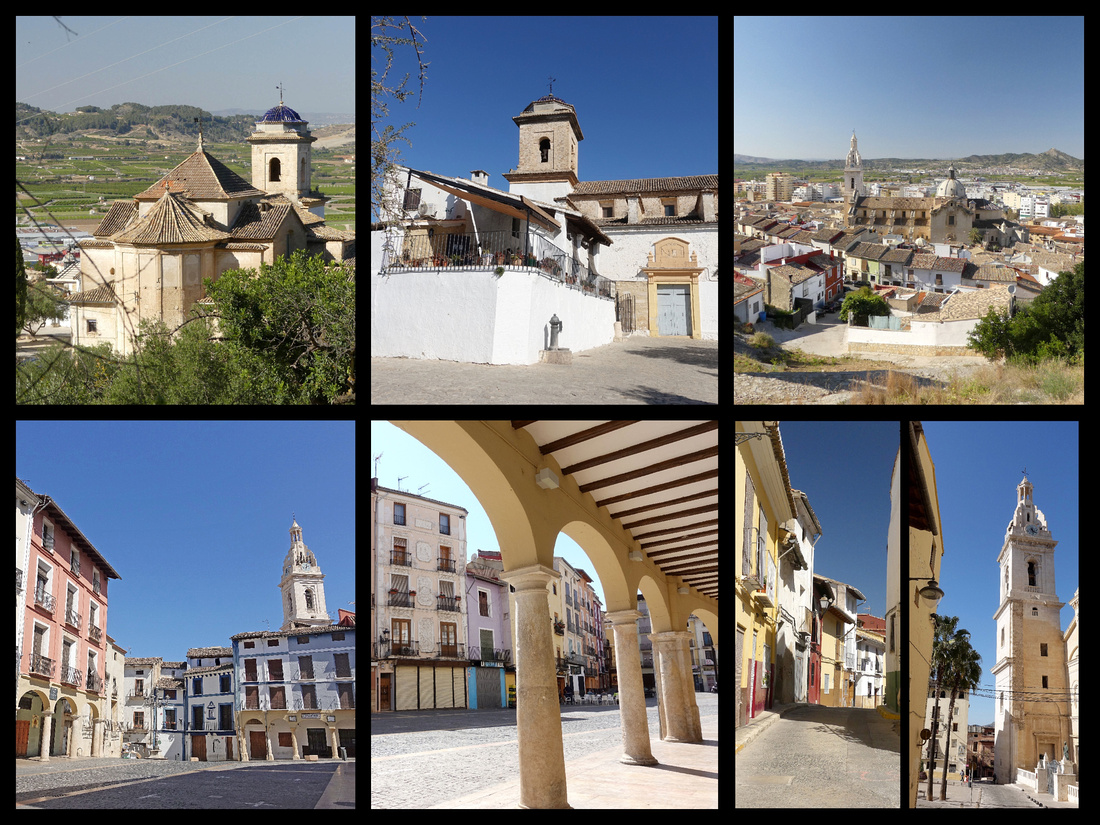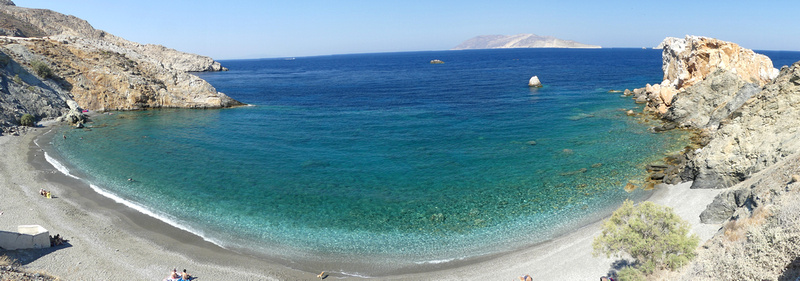


Spring in Spain - Part 2 Tarragona and Valencia
The first half of my spring break in Spain was a week on the islands of Mallorca and Ibiza. After a brief stop in Barcelona I headed to Tarragona for two nights and Valencia for four. Both exceeded my expectations, but especially Valencia.
TARRAGONA
My main reason for visiting Tarragona was to do a side trip to the Poblet Monastery. I arrived at the train station on a beautiful sunny Sunday morning. It's a short walk to the main part of town but it is UP - which makes for great views but a steep climb to get there. I dropped my bag at the hotel (Hotel Placa de la Font) and went to the TI where a very nice lady informed me that the bus to monastery doesn't go on Sundays, and the monastery is closed on Mondays. Guess I didn't research this very well. But there was still a lot to see in Tarragona itself and two days was a good amount of time.
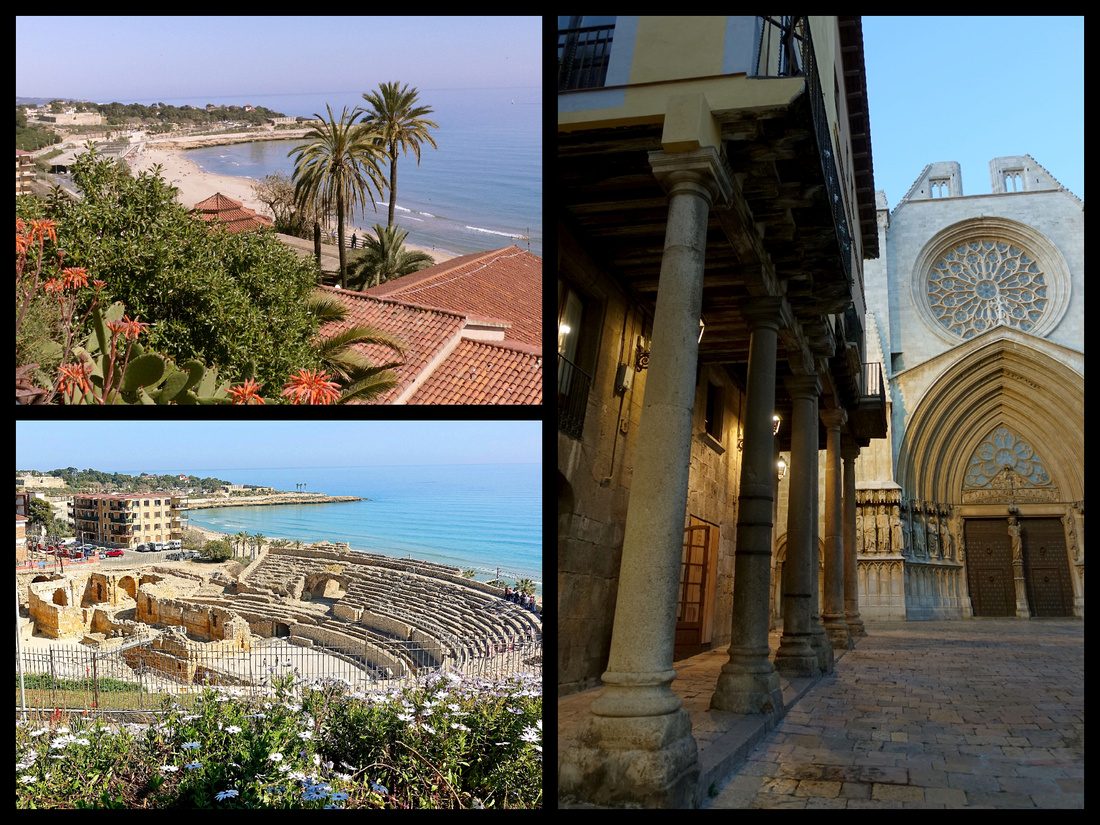

Tarragonna is today a provincial capital with a beautiful setting on the Mediterranean. It’s on the UNESCO world heritage list for the ensemble of Roman archaeological sites that date to when it was the most important city in Iberia. The most impressive is the amphitheater, set right on the water, built in the 1st C AD, could hold 15,000 spectators. There are also ruins of the forum, fairly extensive sections of the Roman wall and a museum. All of these can be ‘visited’ with a ticket, but you can see most of it pretty well without going ‘in’. There are also numerous other Roman bits scattered around town. The map from the TI identifies things pretty well.
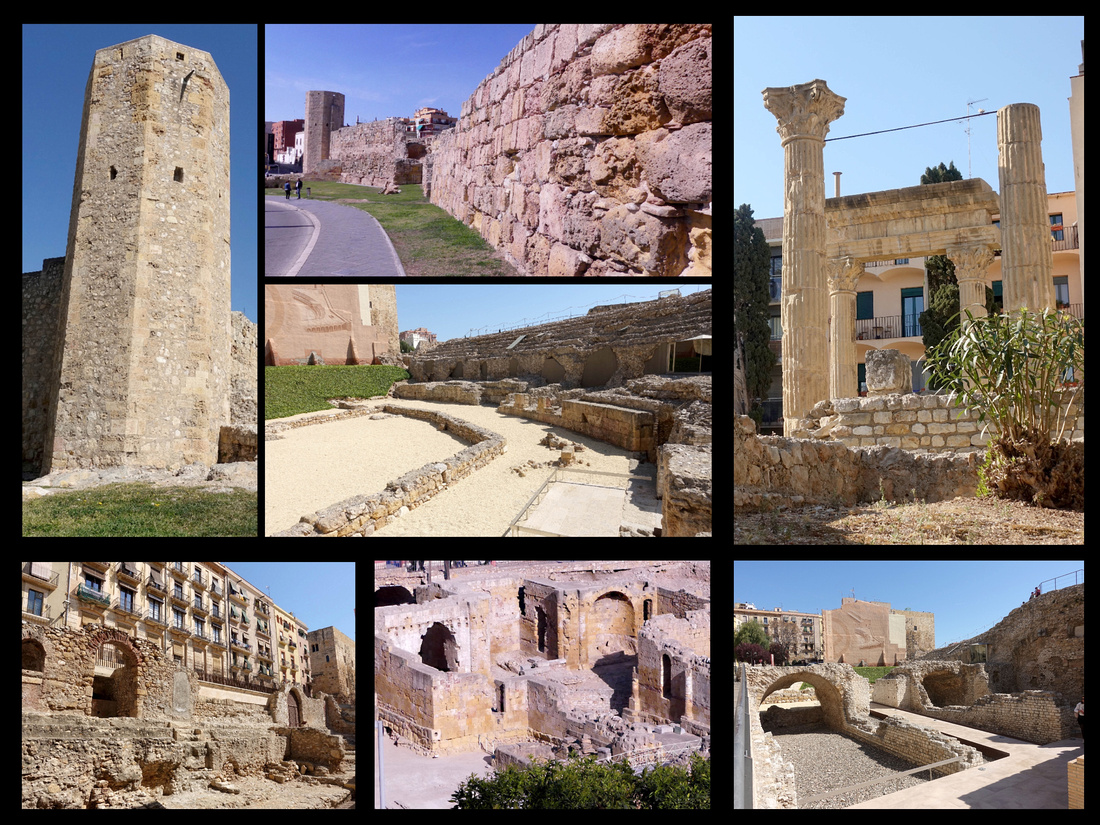

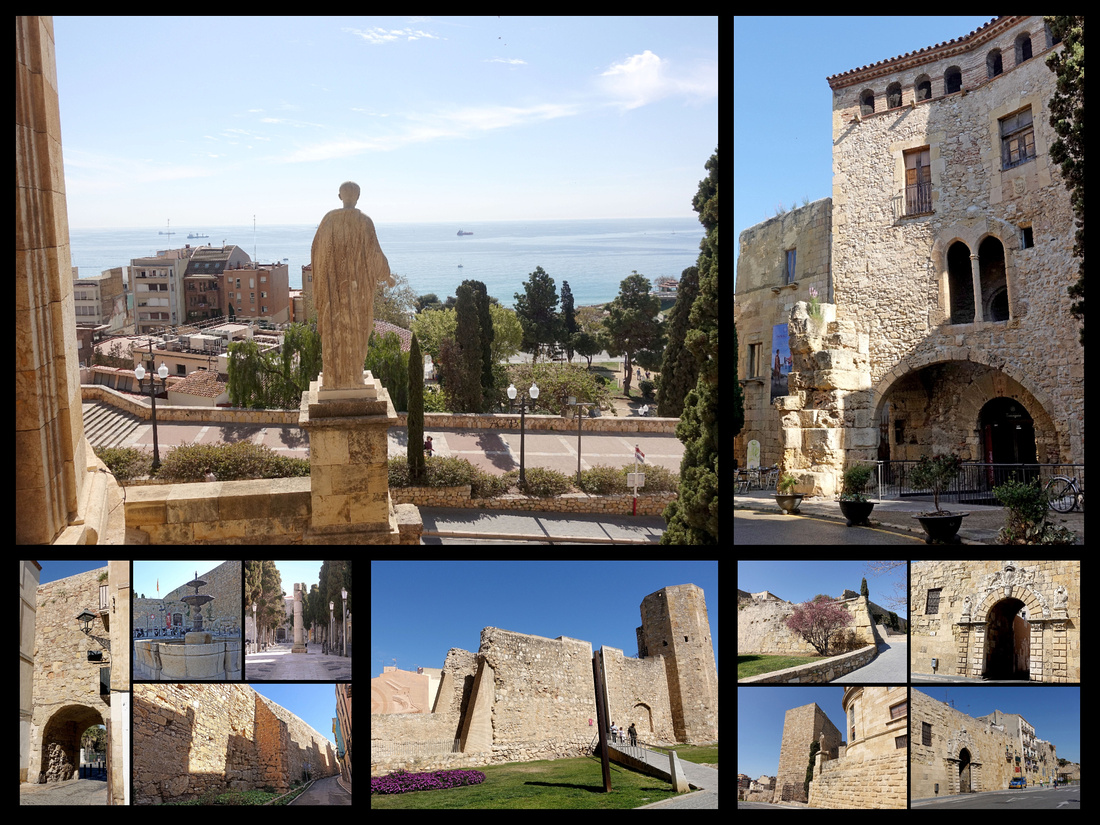

The main street in Tarragona, Rambla Nova, is a wide boulevard with car lanes on each side of a very wide pedestrian center – which is lined with trees and benches. At the top end is the Balcón del Mediterráneo, a terrace with stunning views of the Mediterranean. Steps from the Balcón del Mediterráneo lead down to the railroad station and the beach. Part way down La Rambla is an interesting statue – Monumento de los Castellers. This is a huge sculpture representing a human castle, which is a Catalan tradition in which a "colla" composed of many people create a compact base with their bodies clutching together and then the other members begin to climb up on the shoulders of these forming up to 10 floors easily measuring more than 10 meters high. This is a Catalan tradition, also done in Barcelona, but it’s native to Tarragona and has been around for over 300 years. There are posters and a tile plaque with pictures but the sculpture is the most impressive. Also in La Rambla Nova is a bronze of ‘grandfather’ statue and a nice fountain. Very pleasant avenue. Stores were pretty boring though.
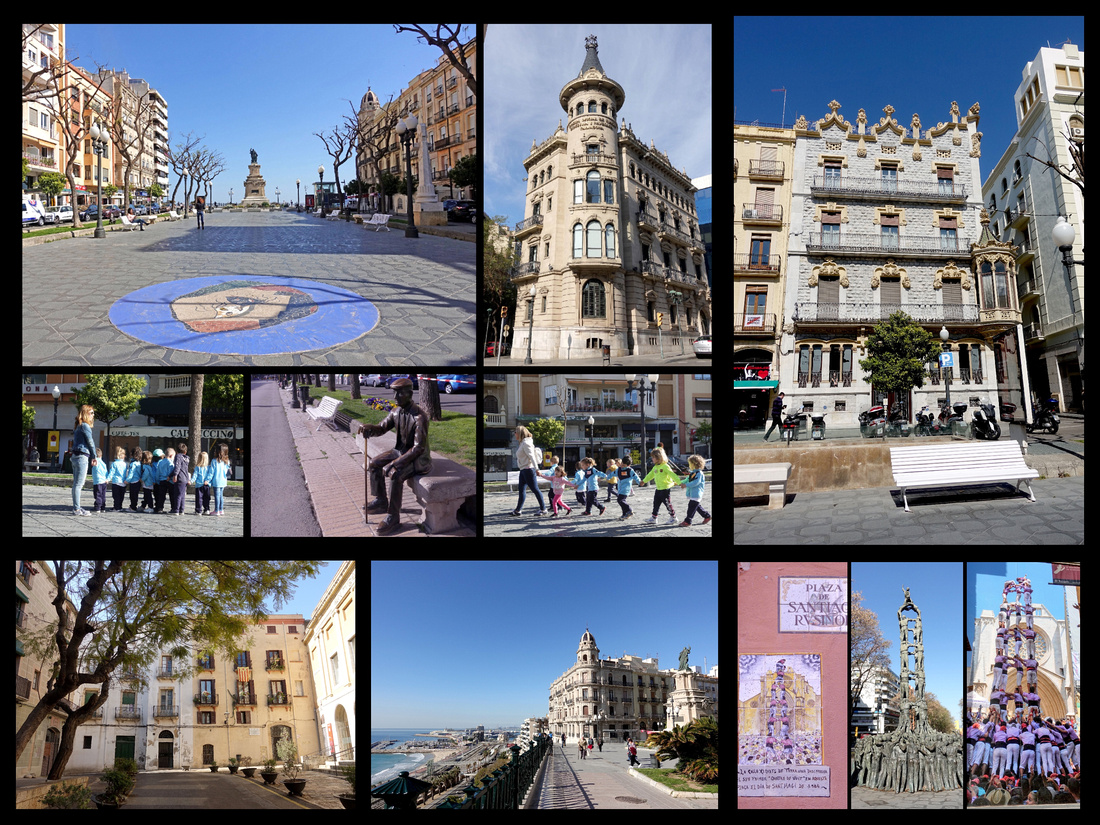

Placa de la Font is a large rectangular square, with the Ayuntamiento at one end.


Tarragona Cathedral (5€) Romanesque and Gothic, is large and really pretty from the outside, inside just average, one side chapel was cool, one side room looks more like a castle room than a church but overall nothing special. The cloister was very nice though, huge, very well kept with five fountains in the center, several of them with gold fish and one with 3 rather large turtles. I sat in the sun against the cloister wall for a while. Most of the time there were only a couple other people there, a few tour groups came through but didn’t stay long, very peaceful. The cathedral’s setting is interesting, at the top of a large flight of stairs on a small plaza, with some atmospheric medieval looking buildings on one side.




Surrounding the cathedral are medieval lanes and alleys, the section of town referred to as “Part Alta”, with houses from the 15th century onward but interspersed with bits of Roman ruins.
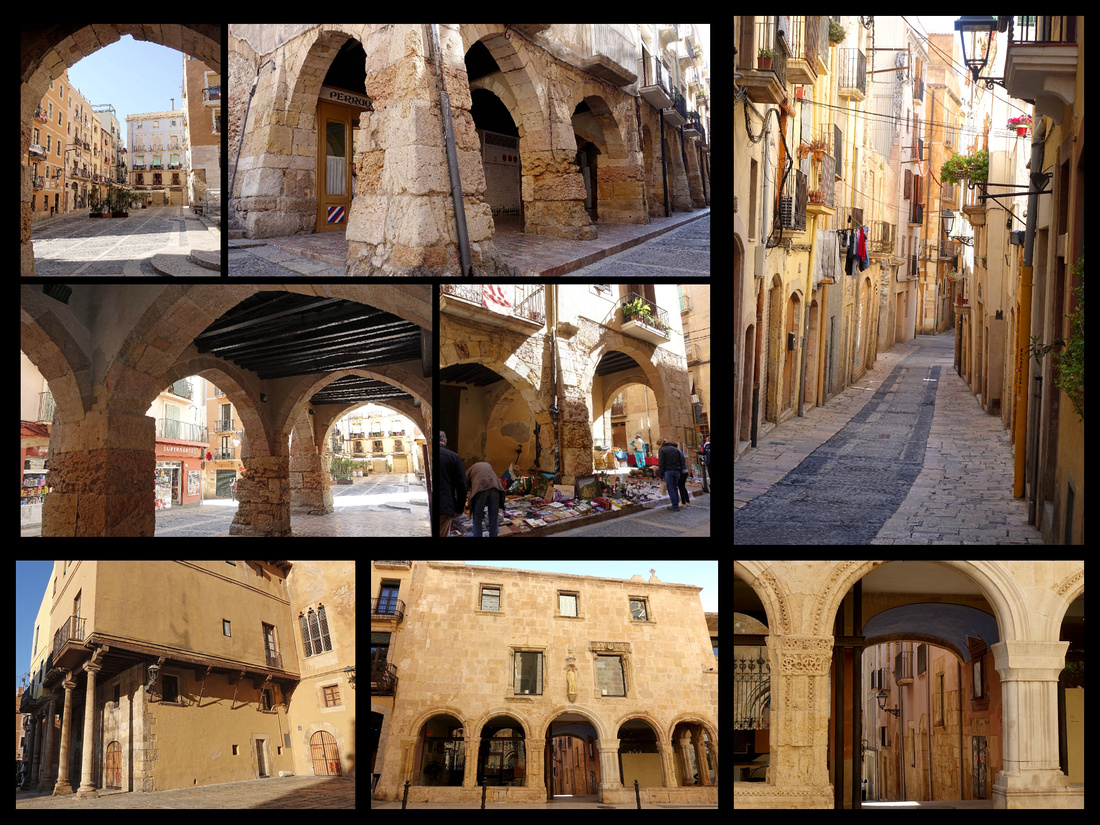

Besides the old town center, Tarragona has a lovely beach (Platja del Miracle) and about a half hour walk past the train station along the water is the old fishing village of El Serrallo. There are a few interesting old buildings, some of the city’s best seafood restaurants, and some boats – but mostly yachts, not much in the way of ‘fishing’ boats.




VALENCIA
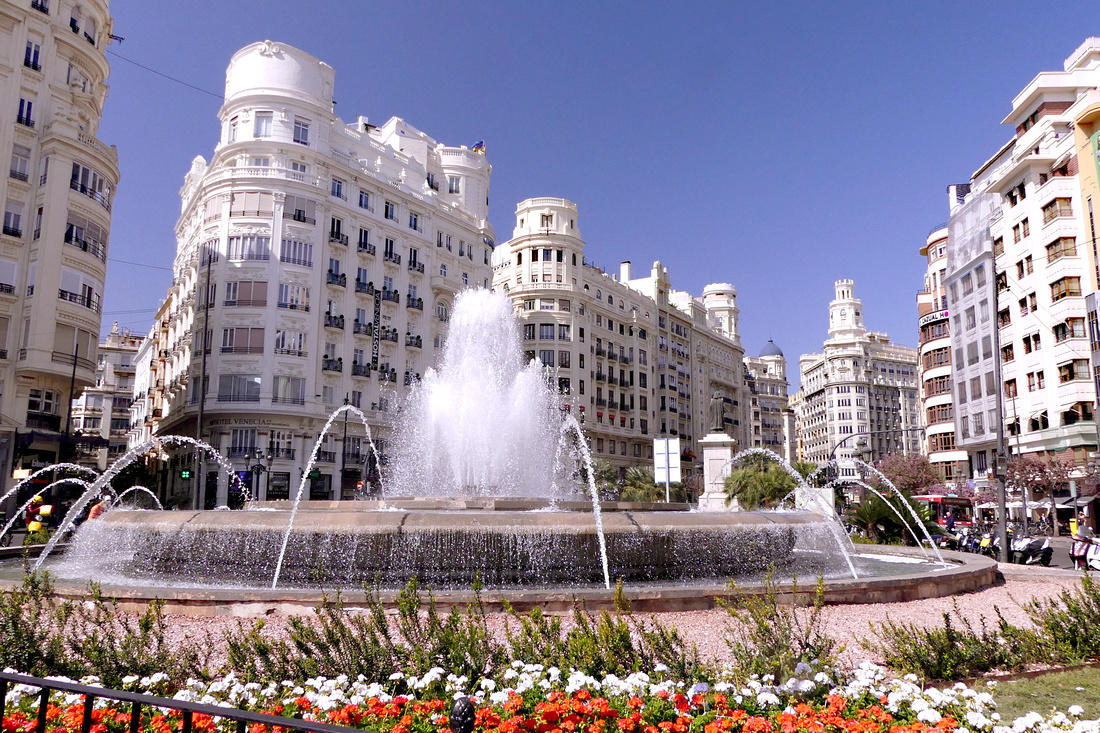

Valencia is gorgeous - I was way more impressed than I expected to be, don’t know why Valencia didn’t come up on my radar before now. The metro area has a population of over 750,000, the third largest city in Spain, but the ‘city center’ is quite manageable, just over a mile across (from Valencia Nord to the Torres de Serranos). About 1½ miles from Valencia Nord to the City of Arts and Science. The center could easily be seen in a full day, but I wandered around it several times, climbed both towers and visited several interiors. Visiting the 'City of Arts and Sciences' took another half day (but you could easily spend a full day there if you visited the museums). I also took a half day trip to Xativa Castle.
My entry point to the city was Valencia Nord train station (the other main station is Joaquin Sorolla, only a 10 minute walk past Valencia Nord, just follow the tracks, free bus between). The train station is beautiful, and then right across the street start blocks of gorgeous buildings. It’s about a 2-minute walk to the main square; I spent the afternoon exploring the city.


Estacion del Norte is Moderniste, 1917, has a main foyer decorated with ceramic mosaics. Next to it is Valencia’s bullring on Plaza de Toros. First sight you see coming out of the train station are gorgeous white buildings lining the block (¼ mile) to Plaza del Ayuntamiento, which is amazing, probably one of the most impressive squares in Europe – gorgeous buildings including the Ayuntamiento (neoclassical) and the Post Office (neo-baroque), probably the snazziest post office I’ve ever seen, the interior looks more like a theater lobby than a post office) plus many more beautiful buildings – certainly rivaling Madrid or Barcelona. The plaza is a huge open area with a huge beautiful large fountain and flower sellers. Just lovely. And Valencia has to be the best smelling city I've ever been to -orange trees are everywhere throughout the city and, at least in March, they were not only full of mature oranges, but also little white flowers.

 Plaza del Ayuntamiento
Plaza del Ayuntamiento
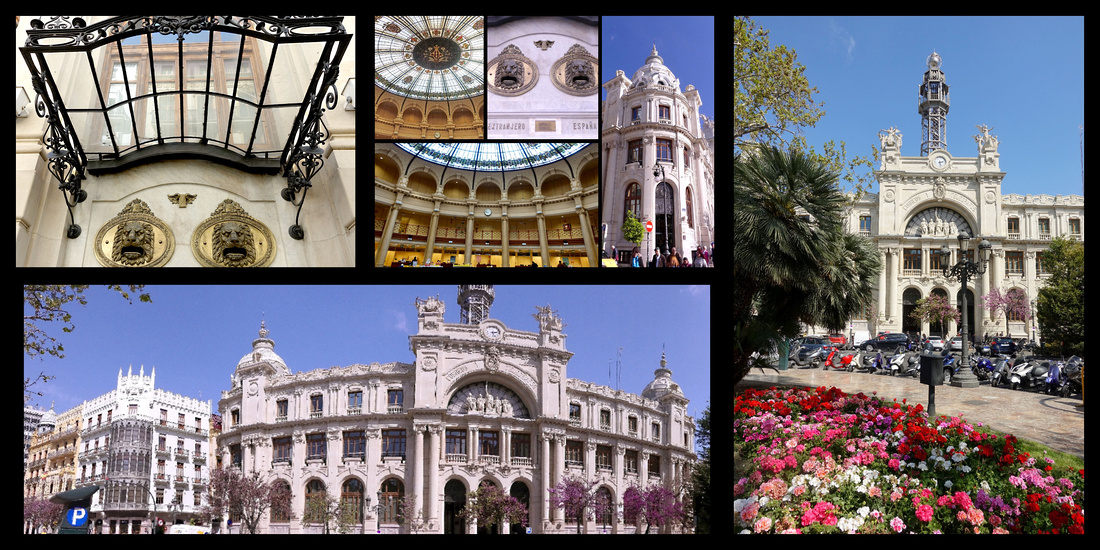
 Valencia Post Office
Valencia Post Office
The main part of the city is the oval area inside the Calles de Colon (ring road) where there are three major squares: besides the Plaza del Ayuntamiento there is the Plaza de la Reina and Plaza de la Virgen. The oldest quarter of the city, the Barrio del Carmen (aka El Carme) is delimited by Plaza de la Virgen, the Torres de Quart and Seranos and the Turia riverbed park.

 Typical Valencia buildings just off Plaza del Ayuntamiento
Typical Valencia buildings just off Plaza del Ayuntamiento
Plaza de la Reina –(aka Plaza de Zaragoza) is a busy square, lots of traffic, but lined with nice buildings with the main entrance of the cathedral at one end. It is the official ‘center’ of Valencia, many streets meeting here, it’s book ended by the old town’s two best towers, the Micalet and at the other end, Santa Catalina, an 18th Century baroque belfry, one of the city’s best known landmarks.
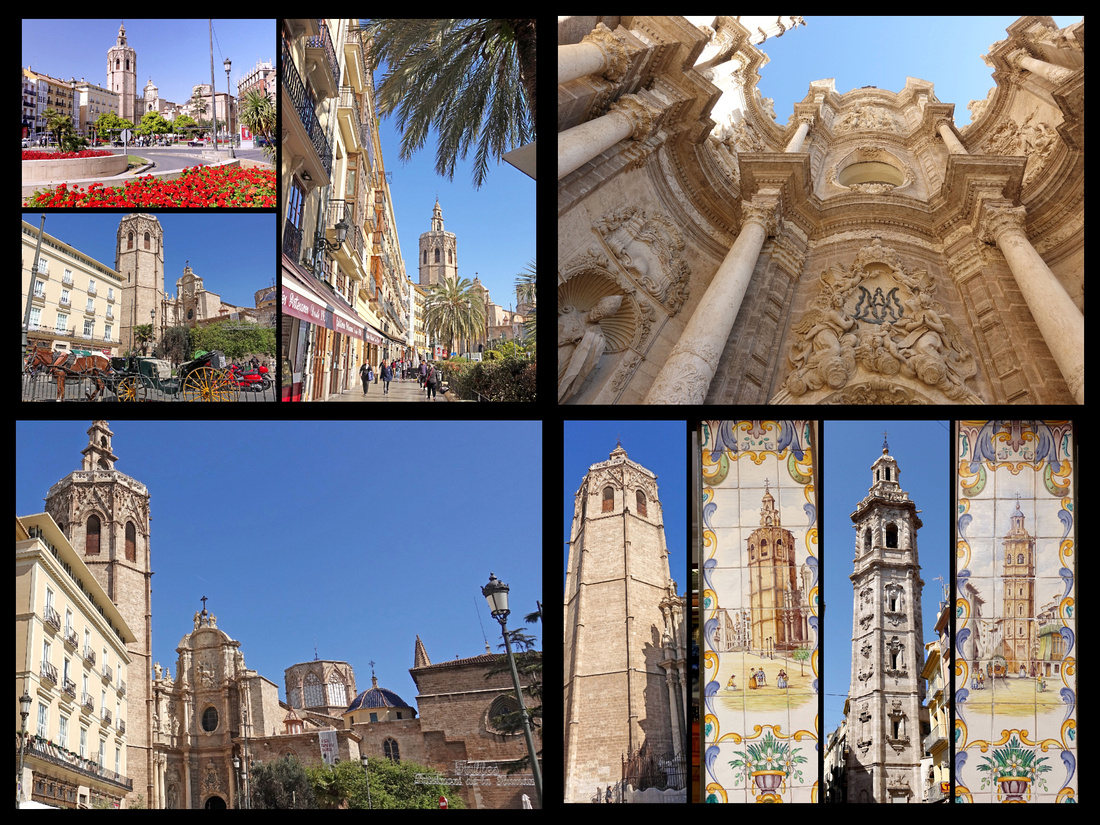

Plaza de la Reina - top right: main entrance to the cathedral, bottom right: Micalet on the left and Santa Catarina on the right was
Plaza de la Virgen was site of the Roman forum of Valencia and now a pedestrian square with the cathedral and the smaller church of Nuestra Senora de los Desamparados as well as the 15th century Gothic Palau de la Generalitat, seat of government for the Valencia region and a beautiful fountain. The Catedral (Seu) is one of the oldest buildings in Valencia, a medieval cathedral built in fortress-like style between 1252 and 1482 on the former site of the Grand Mosque, a former Visigoth Cathedral and a Roman temple of Diana. The cathedral embodies several design styles but good old Spanish Gothic predominates. The tower known as Miguelete (“Micalet” in Valenciano), right next to the cathedral is Gothic. The Puerta del Palau on Plaza de la Virgen is Romanesque; the dome, tower and Puerta de los Apostoles are Gothic; the presbytery and main entrance on Plaza de la Reina are baroque; and there are a couple of Renaissance chapels inside. It claims to house the Holy Grail, the chalice from which Christ sipped during the Last Supper.


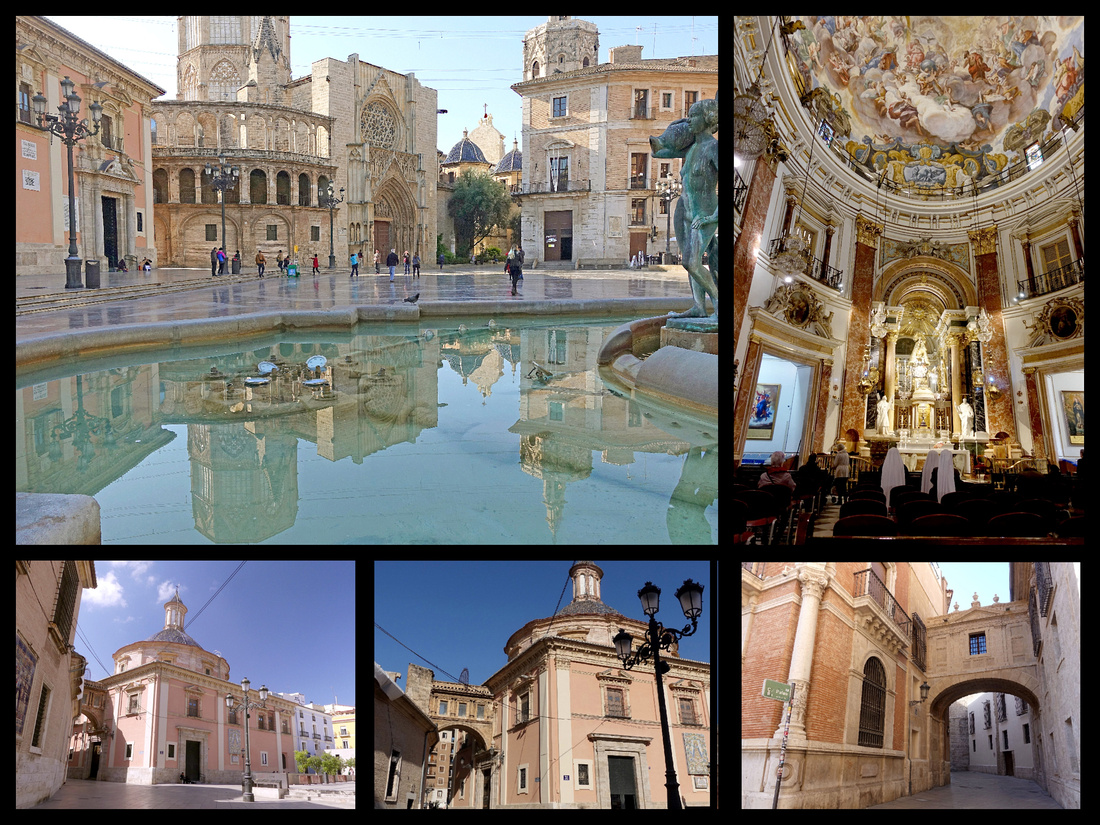

Top left: cathedral reflecting in fountain pool on Plaza de la Virgen, Top Right: interior of Neustra senora de los Desampanados
Bottom: rear side of Neustra senora de los Desampandos and archway connecting it with the cathedral.


Palau de la Generalitat on Plaza de la Virgen
Torres de Serranos is the 14th century town gate which leads to Barcelona, and Torres de Quart is the 15th century gate which faces towards Madrid, the kingdom of Castile and the setting sun. Both towers are impressive whether approaching from the outside, or already “inside the walls”. Both can be climbed and are larger and more extensive than they appear from the outside. Torres de Serranos lies just inside the city from an especially nice section of Jardin de Turia, the riverbed park.




Above: Torres de Serranos


The walk between the Torres de Serranos (above left) and Torres de Quart (above right) leads through the old streets of Valencia (above center)
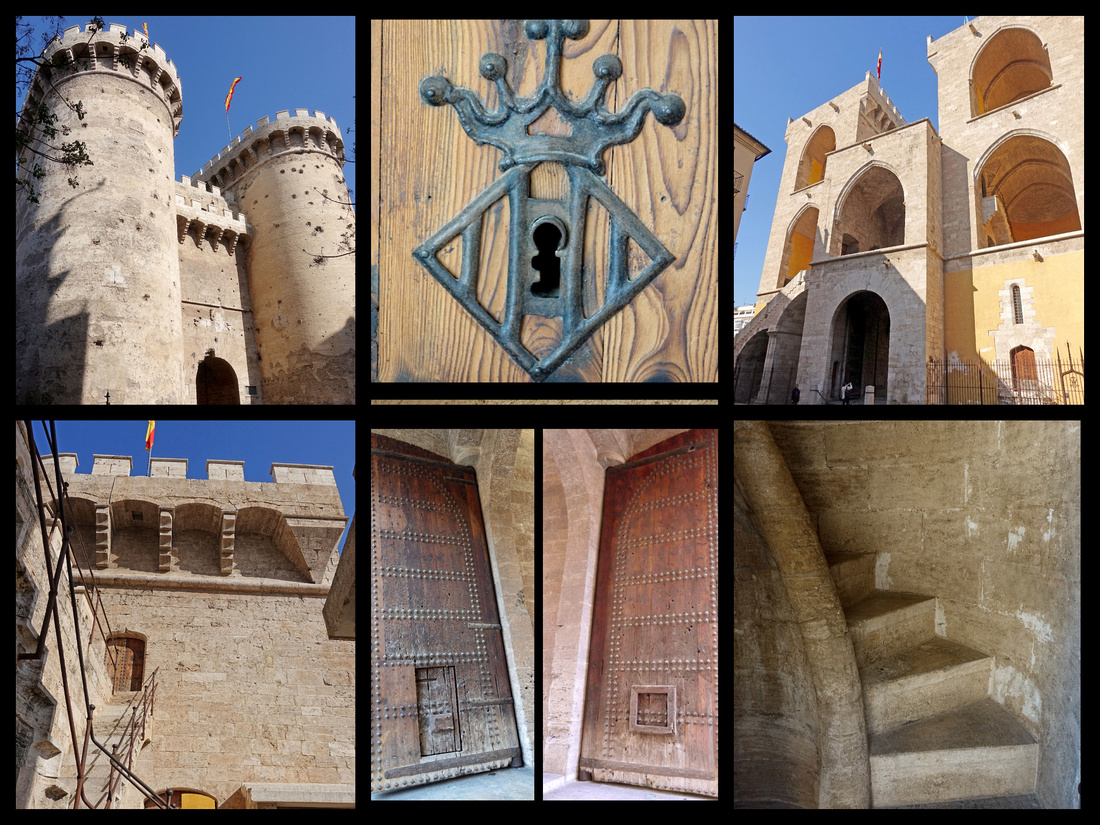

Above: Torres de Quart
Another main area of interest is around the main market. Mercado Central, Plaza Mercado, is Modernista in style (1928), one of the best food markets in Spain, not quite rivaling La Boqueria in Barcelona but impressive enough, if somewhat more sedate (and with a lot less tourists). Heavily featured are Valencia oranges, which were in season in March. Several places I saw signs for “Aqua de Valencia” (OJ).


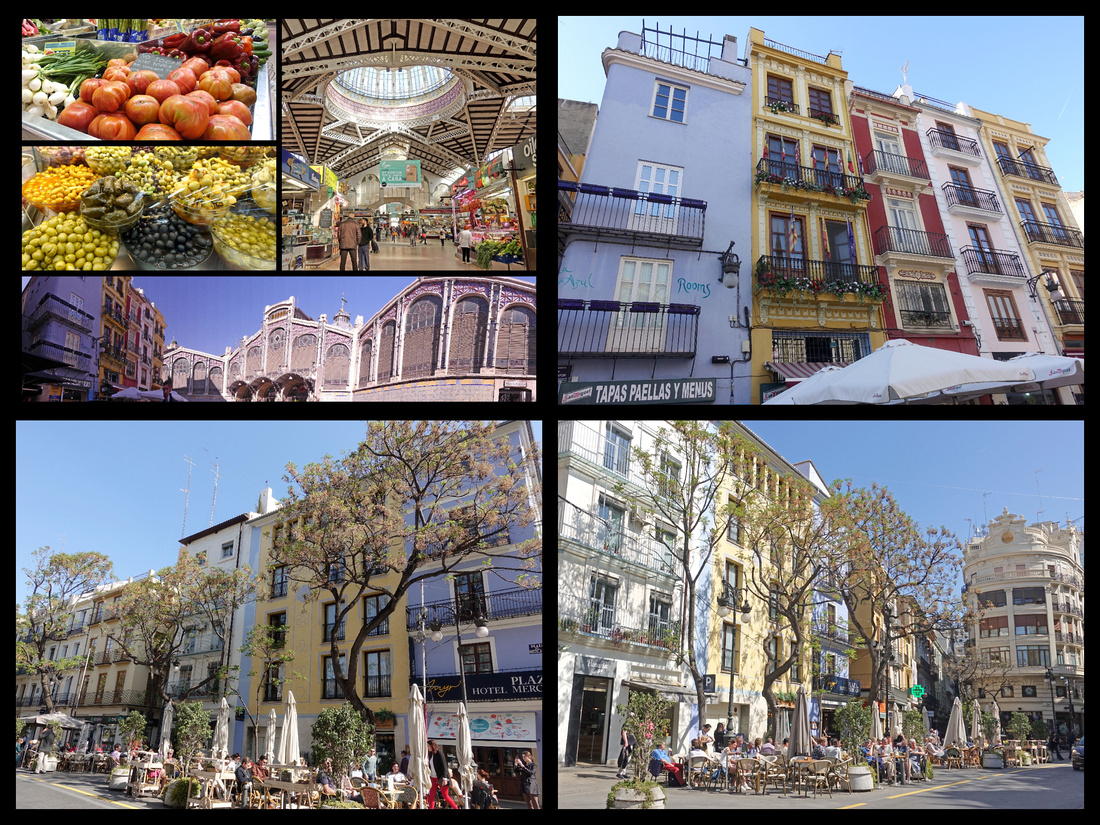
 Above: the main market and the streets adjacent to Plaza Mercado
Above: the main market and the streets adjacent to Plaza Mercado
Just across the street is one of the prettiest, most interesting buildings, La Lonja de la Seda, built between 1482 and 1533, originally used for trading in silk (hence its name, the Silk Exchange) and it has always been a center for commerce. It is a masterpiece of late Gothic architecture. The grandiose Sala de Contratación (Contract or Trading Hall), illustrates the power and wealth of a major Mediterranean mercantile city in the 15th and 16th centuries. Listed as a UNESCO World Heritage Site, it is considered a top example of Gothic civic architecture. A forest of twisted columns supports the main trading hall, and the tranquil central courtyard is full of orange trees and a fountain. Besides being in a stunning state of preservation, the Lonja features some truly disgusting gargoyles. Walking around the building, both inside and outside on the facade, you can find all manner of perversion in the decorations: chimeras biting women’s breasts, a maiden fondling the genitals of a bent-over pauper, acts of bestiality, drunken men peeing into jars and more. These gargoyles are meant to represent the sins of humanity… and they don’t overlook many types of deviance.
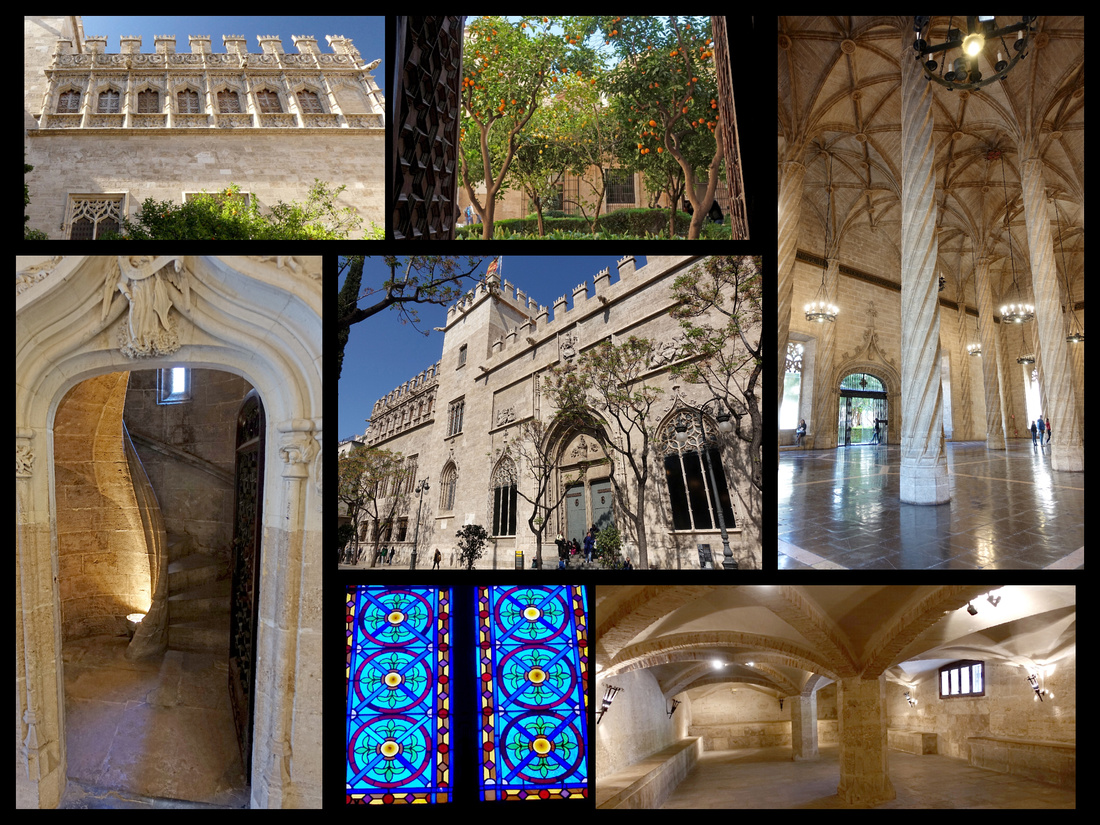

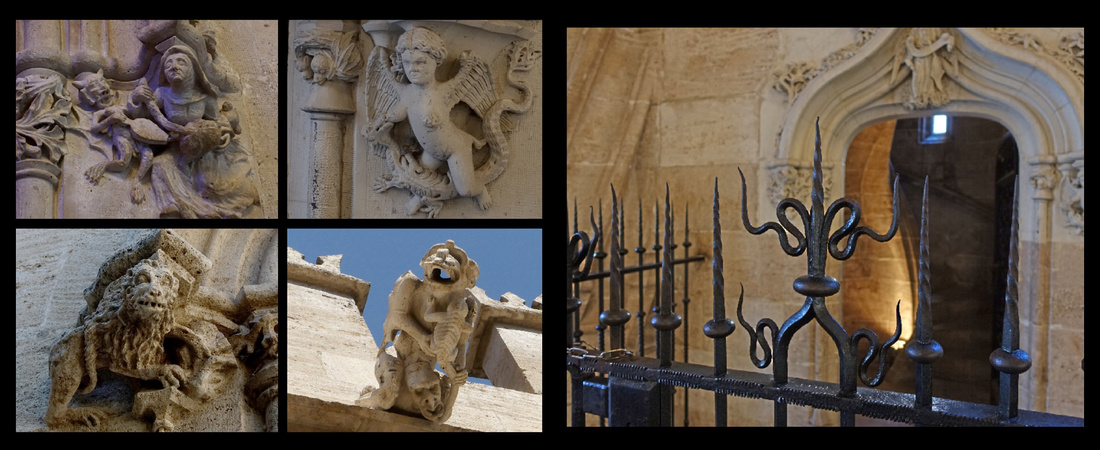

Between Plaza de la Reina and Mercado Central there is a perfectly round square. Redonda has been a part of Valencia’s layout since 1837, when it was a fish and meat market. Eventually, it became a place for sewing supplies; today there are still stalls dedicated to fabric and thread. A few years ago, the plaza was given a rather hideous makeover. The old stalls, which had been arranged in a circle around the perimeter of the plaza were moved into the center, and an ugly modern awning was added. Posters at the entrance show what it used to look like.
Just behind Lonja is Placa del Dr. Collado, a small square with a hardware shop which looks as though it’s been there for centuries. Café Lisboa, bohemian vibe, terrace tables arranged underneath the branches of a colossal, gnarled olive tree. For many years, this plaza had been the site of Valencia’s Lonja del Aceite, or Oil Market. The olive tree, as a symbol for oil, was planted in the corner to remind people of the plaza’s former purpose.
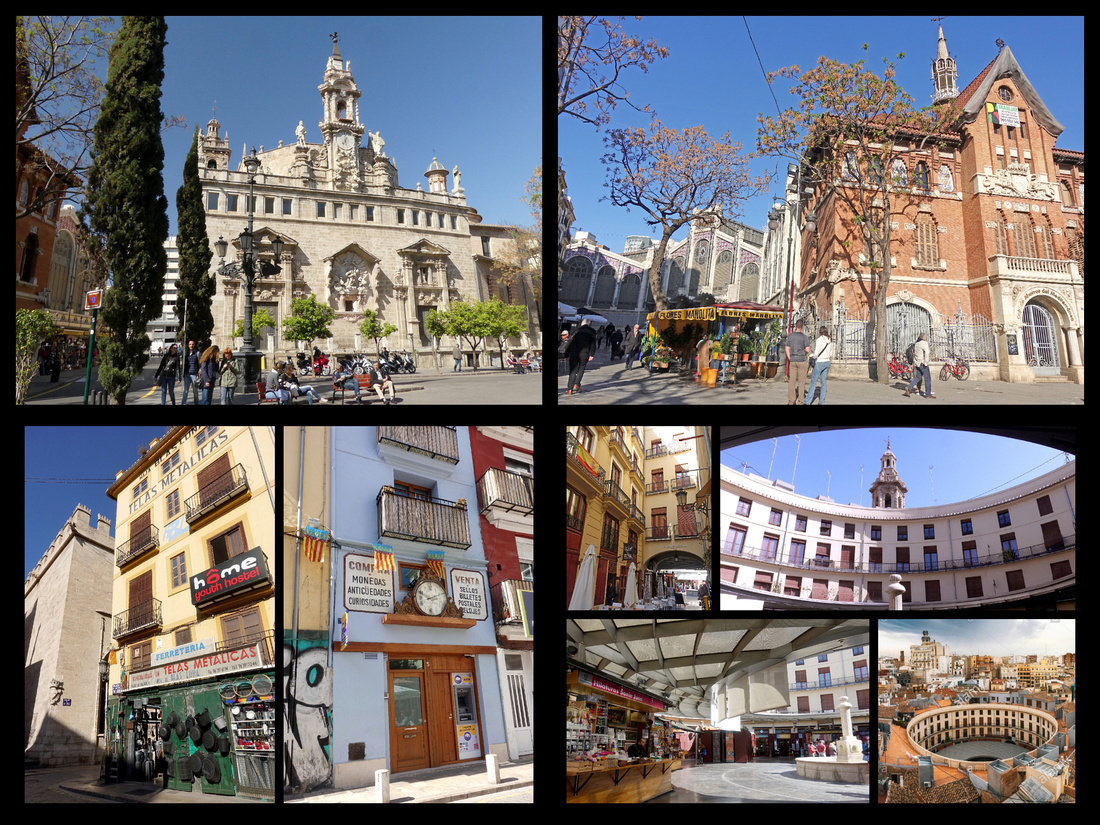

Top left: church across the street from the Lonja, top right: between that church and the market, bottom left: Placa del Dr. Collado, bottom right: Redonda
The other side of the old town has a few noteworthy buildings as well. Palacio del Marques de Dos Aguas, 15th C Gothic, radically reformed in 18th century Baroque. A lot of historic buildings in Valencia have beautiful doors, but the grand prize must go to the marble entryway of this building. It houses the González Martí National Museum of Ceramics and Sumptuary Arts and consists of four floors arranged around an interior courtyard. The entryway is magnificent but sides of the building feature some very nice decorations as well and there’s a tranquil fountain on one side.


Plaza del Patriarca – a rectangular square with a symmetrical grid of orange trees, and home to a couple of Valencia’s oldest buildings: the Real Colegio Seminario del Corpus Christi and La Nau, both of which date from the 15th century. La Nau is the historic seat of the University of Valencia, 1498, centered around a spacious courtyard. The Colegio del Patriarca (or Seminario del Corpus Christi) has monks still living there, and every morning at 9:30, in the choir of the church, you can hear Gregorian chants. The church is covered in frescoes. In the foyer of the church, is the “Dragon of the Patriarch,” a stuffed crocodile mounted on the wall over the holy water basin. According to legend, this was a dragon who lived in the Turia River, terrorizing the people of Valencia. In exchange for a pardon, a Jewish prisoner agreed to kill the dragon. When the fateful day came, he approached carefully, and at the right moment, threw off his robe, revealing a dazzling suit of mirrors which dazzled the beast, and allowed the makeshift knight to deal out the killing blow. (In truth, the Dragon of the Patriarch is a crocodile brought back from one of the first Spanish ventures to South America).
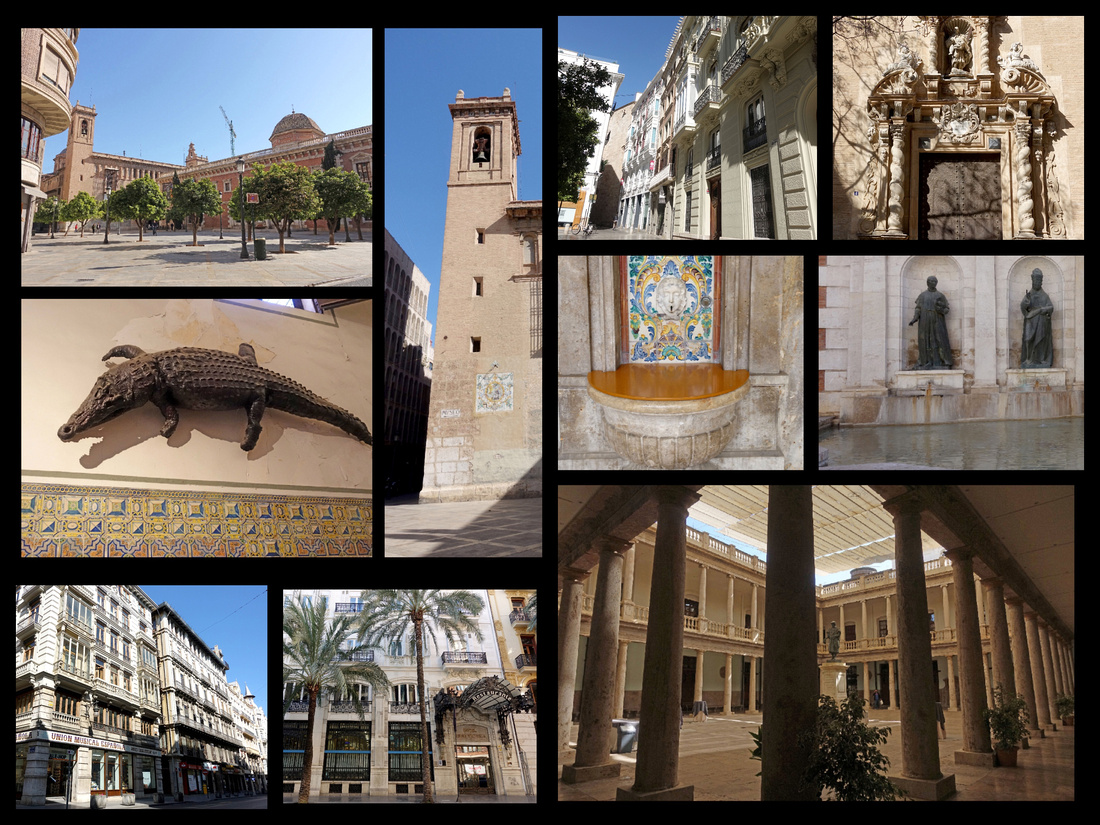

The rest of central Valencia is just as impressive. Throughout the old town there was a lot of interesting street art (mixed in with normal graffiti). Outside of the oldest part of town are some lovely avenues with pedestrian centers, lined with beautiful Valencia style buildings (several modernista style) and palm and orange tress. In this area is the other major market, the Mercado de Colon on Called de Cirilo Amoros, a modernista building, which now houses boutiques and cafes. Ave del Regne de Valencia leads out towards one of the ‘must sees’, the City of Arts and Sciences.
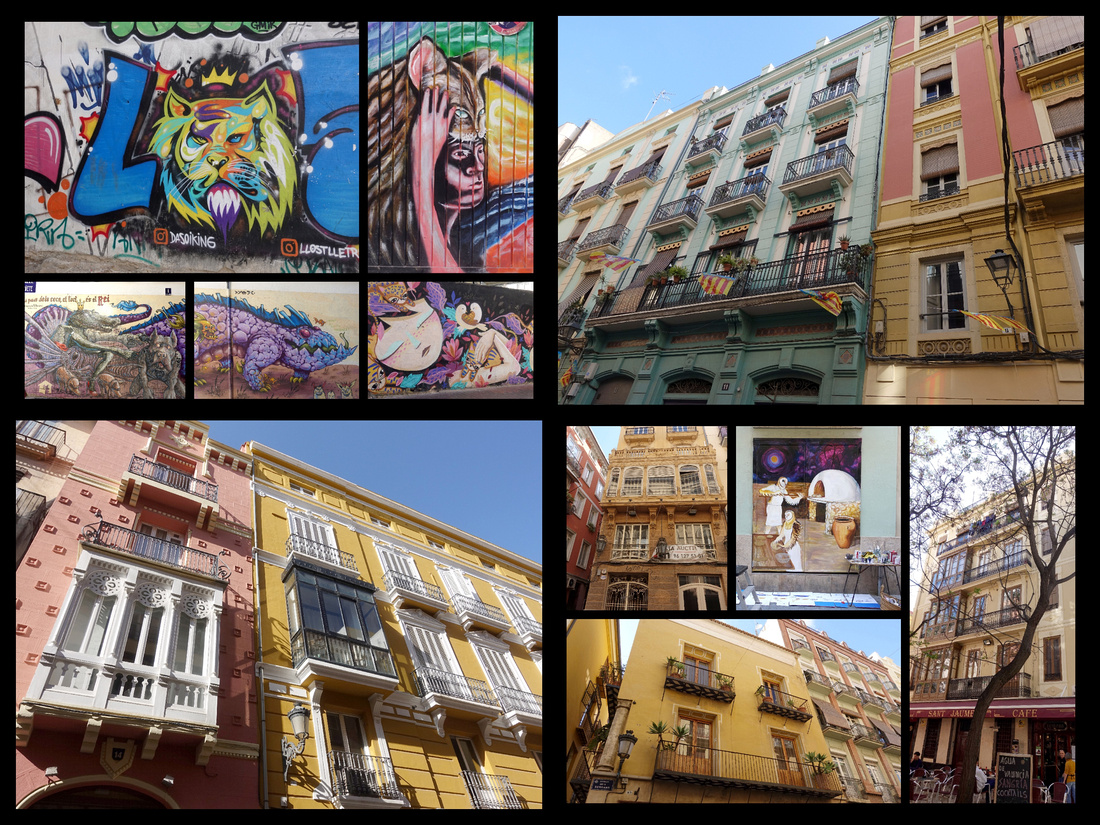

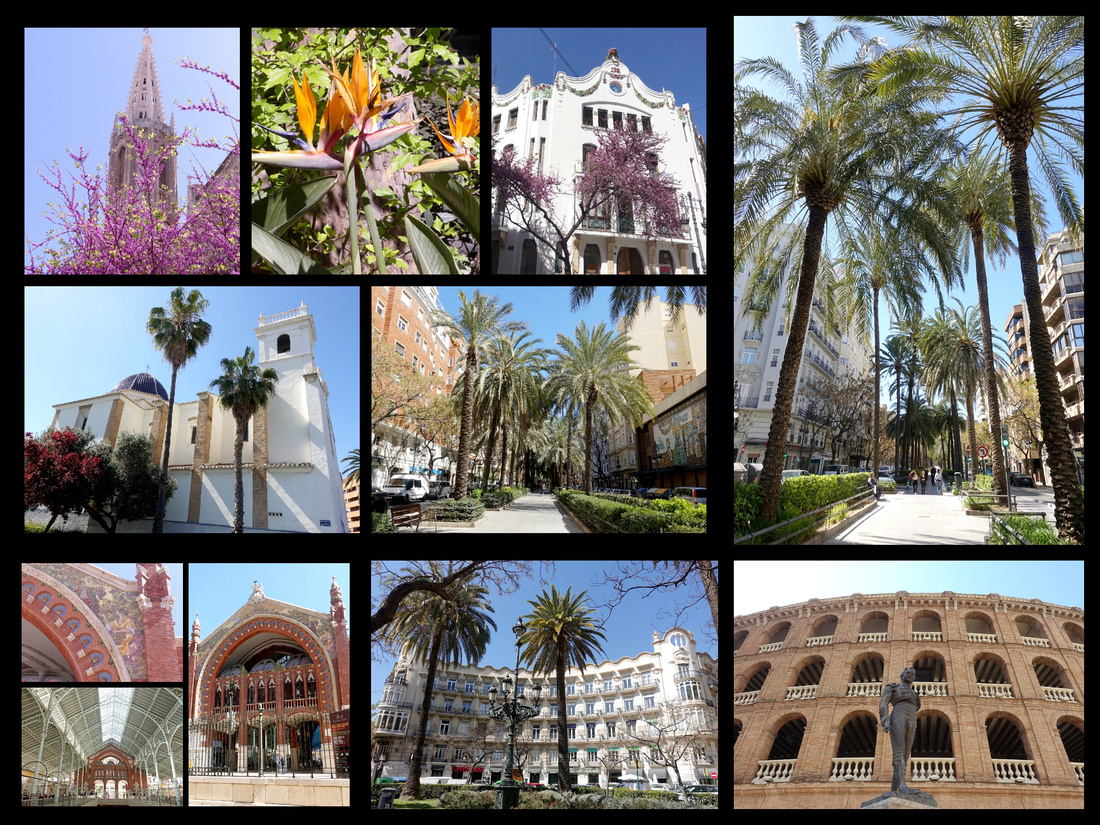
 Above - Top photos and bottom center: Avenue Regne de Valencia Bottom left: Mercado Colon Bottom right: Valencia Bullring
Above - Top photos and bottom center: Avenue Regne de Valencia Bottom left: Mercado Colon Bottom right: Valencia Bullring
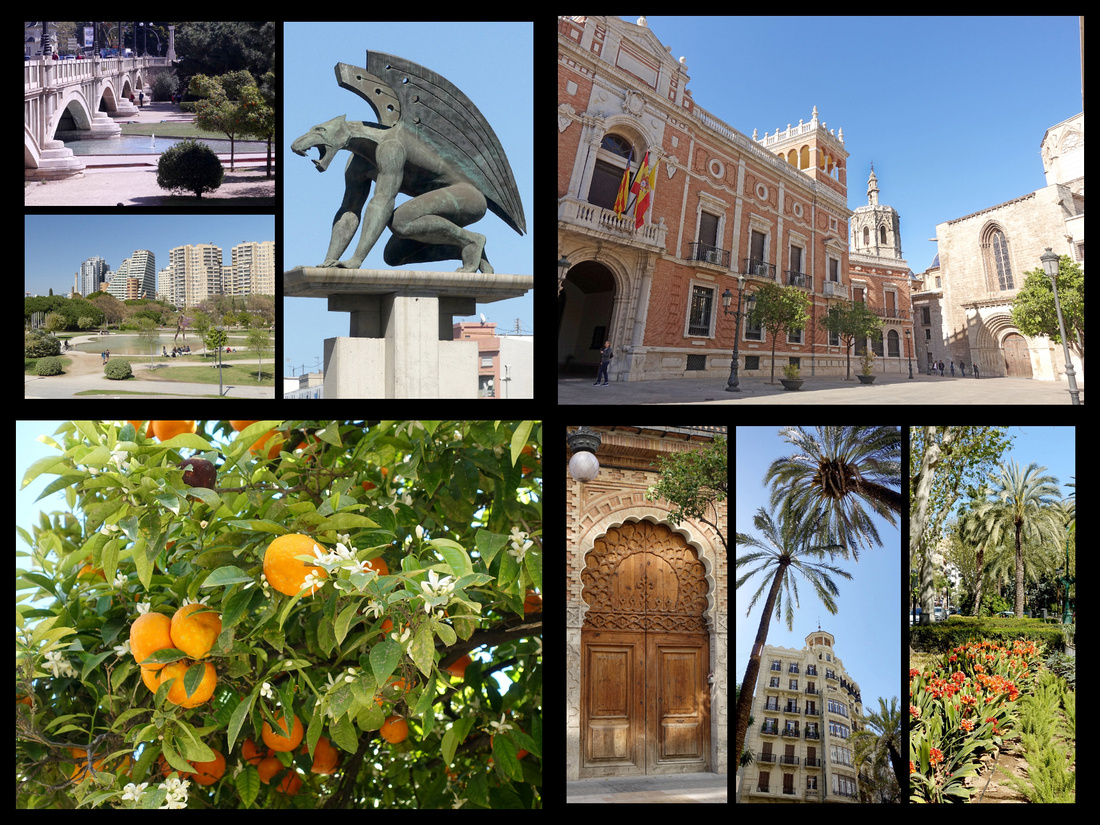

Above - Top left: Jardi del Turia Top right: building in center of Valencia behind the cathedral
Bottom photos - the walk from Valencia Nord to City of Arts and Sciences
The Jardi del Turia, is a park built along the former Turia River. After many floods the city of Valencia had the river diverted and in it’s place built a park, which now stretches all the way around the city center. In the center of the park sits The Ciutat de les Arts I les Ciencies (City of Arts and Sciences), blindingly white and futuristic buildings surrounded by blue reflecting pools - the whole thing is gorgeous. Largely designed by Santiago Calatrava, the engineer-architect previously known for visionary bridge designs and the World Trade Center Transportation Hub in NYC. The buildings house halls of science, art and performing arts but the space and the architecture are really the highlights. L’Hemisfèric, resembles a giant eye and eyelid and contains a massive IMAX theater, a planetarium, and a laser show. El Museu de les Ciències resembles the skeleton of a whale.
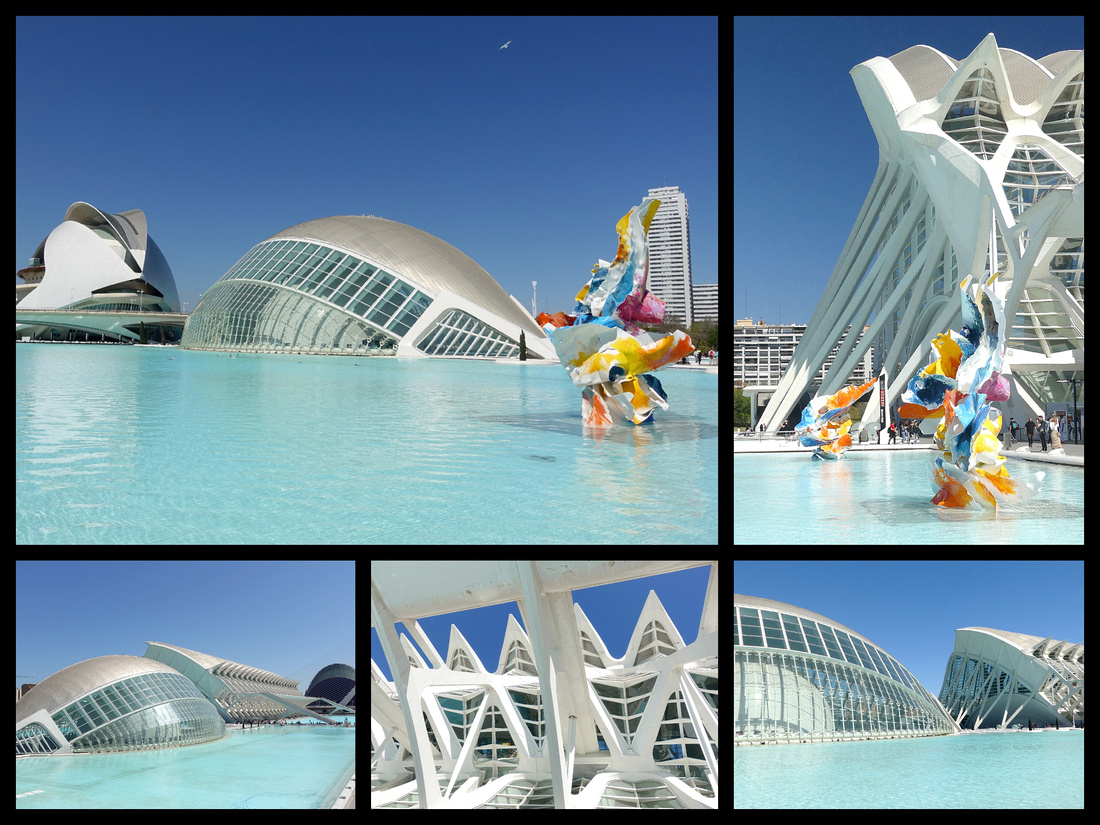

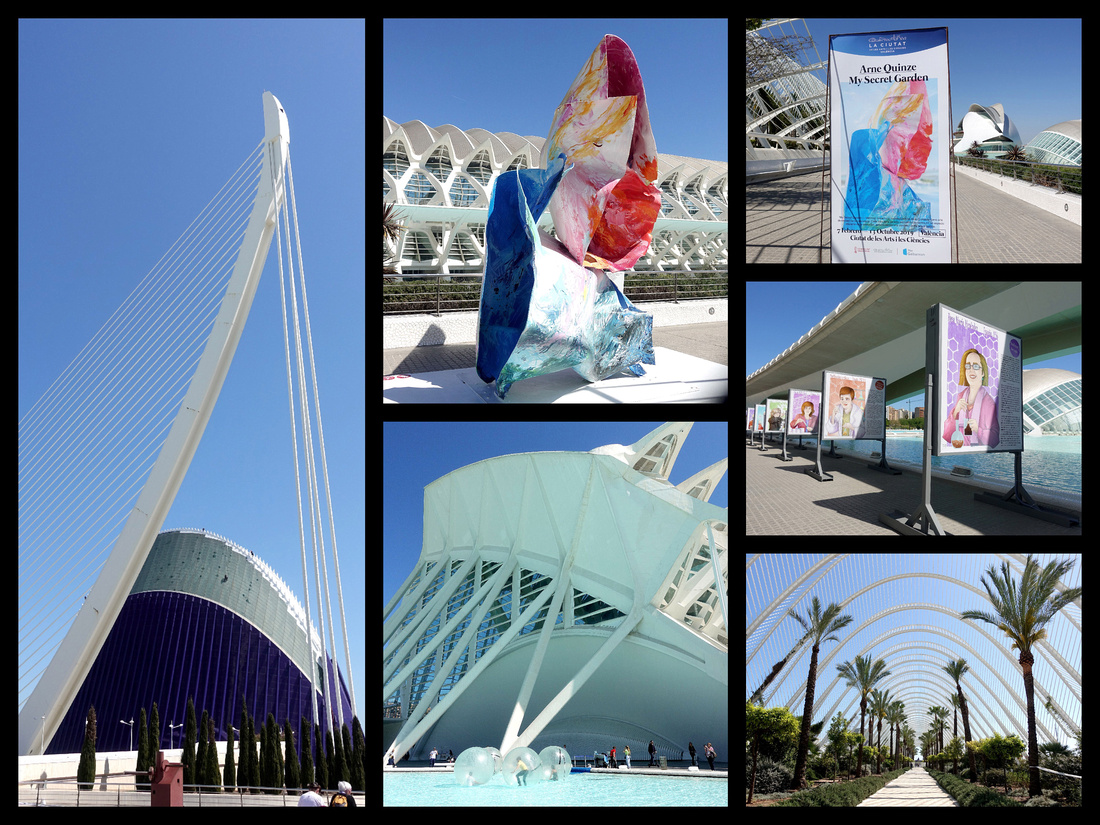

The City of Arts and Sciences features exhibits which change every six months or so. When I was there the exhibit was called "My Secret Garden" made up of numerous colorful 'flowers' which added to the otherwise all blue and white scene. There was also a poster exhibit of female scientists from around the world and throughout history.
Valencia is beautifully lit in the evening. The main fountain on Plaza Ayuntamiento has a light show, with the colors changing every few minutes.


Plaza Ayuntamentio beautifully lit with colored fountain. Bottom left: some shots from the Fiesta which took place just a week before I got there. I missed it buy my friend Nikki supplied a few photos - looked like it was fantastic.
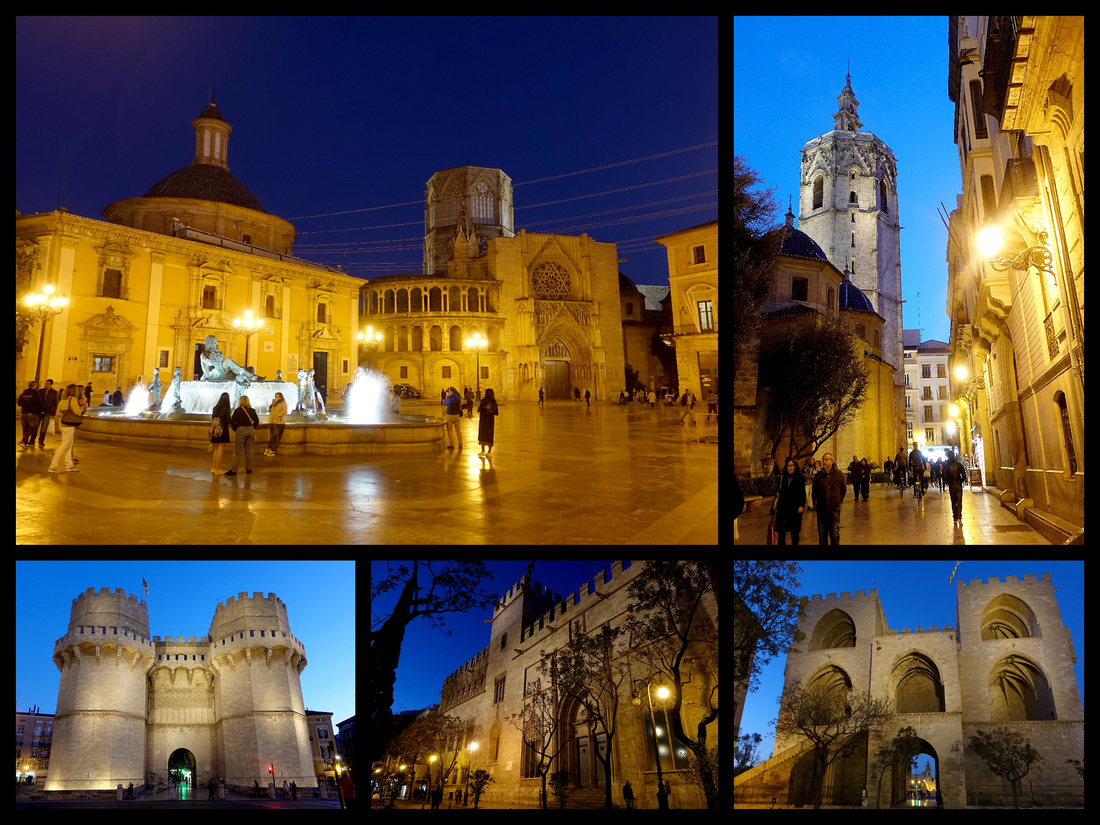

XATIVA
I took a half day trip to Xativa on another warm, completely cloudless day. I’d been checking Renfe website for a few months and it always showed only a 7 am and then a 13:00 train to Xativa. I figured that was weird but it was always that way, regardless of date. Anyway, I went to the train station a little after noon to find there were three trains within the hour. I got the 12:38 which arrived just under an hour later. The train station is reasonably large (the town is 28,000) with a manned ticket booth, small café, and WC. What it did not have was a TI or a sign to the castle. But you could see the castle up on the hill and I started walking towards town (with the castle on the other side of it), probably went a few blocks out of my way but eventually saw a sign for the TI where I got a map and was told is was 3km up hill, there was a ‘tourist train’ but that wasn’t going again until 16:30 (it was only 14:00 at this time) so I started walking. There were little signs, although a few places there were a choice of directions and no sign. One was actually a good mistake, it was only a block off course and there was a really cute little square (Market Square) – just a block past the cathedral. One other spot I had to ask a little old lady directions. I pointed up and said ‘castelo ?’ and she pointed to the correct street.
Part way up is a bar/restaurant/church and a map and signs showing two routes: the ‘old route’ (goat path) and the ‘wall route’ (car path). There were a couple Americans and a group of four Brits looking at the sign. The Americans (Shelly and Jeff from St George Utah) and I took the ‘wall route’ and the Brits took the goat path and we all got there at the same time. Took me just under an hour (45 minutes) going back. But I had Shelly and Jeff to keep me company, always nice to have someone to pal around with for a few hours when solo traveling. The castle is quite impressive – it’s mostly wall with a few inside bits but it’s quite large and strung along a hill with views to the city (which is unfortunately quite built up although the Cathedral and the church halfway up are scenic) and on the opposite side it‘s more rural. The smaller portion of the castle was closed for renovation which was unfortunate because, even though it’s the much smaller part it probably had great views of the larger part. The hike back down was almost as bad as the hike up, got a tad lost (couple blocks) looking for the train station, there was a train in 7 minutes and I arrived back at Valencia Nord exactly 5 hours after I left. From the Xativa train station to the castle and back was 13,700 steps, 75 flights.
